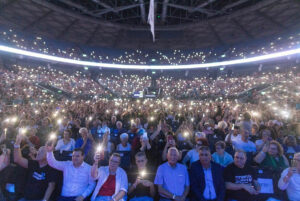A flawed peace conference offers a radical proposal: hope

Israeli-Palestinian peace conference in the Menora Arena calling for an end to the war and a solution to the conflict, Tel Aviv, 1 July 2024
Haggai Matar writes in +972 on 4 July 2024:
At first glance, the Israeli-Palestinian peace conference in Tel Aviv on July 1 appeared detached, almost delusional. And in some ways, it was.
With around 6,000 attendees, the event was the country’s largest anti-war gathering since October 7, outside of street protests. As they filed into the Menora Arena, giant screens displayed a video from 2019 about a group of musicians from the southern city of Sderot who teamed up with a group in Gaza to create a joint music and dance video. As if to further emphasize the stark distance between that time and our current one, it was immediately followed by a segment from John Lennon’s song “Imagine.”
This idyllic atmosphere inside the stadium was shattered by the first group of speakers to take the stage: Jewish and Palestinian citizens of Israel, whose family members were killed or kidnapped in the Hamas-led attack nine months ago, or killed in Israel’s ensuing bombardment of Gaza. One speaker, Liat Atzili, was herself kidnapped and held captive until late November.
Listening to each speaker’s personal horror stories felt like being punched in the stomach over and over again. There was hardly a dry eye in the audience — especially when they collectively read the poem “Revenge” by the late Palestinian poet Taha Muhammad Ali, as a collective stand against retribution. In between such stories, in what felt like an unbridgeable emotional leap, peace anthems were sung throughout the event, including the uplifting “Today,” “The Prayer of the Mothers” and “Song for Peace” — forever associated with the assassination of Prime Minister Yitzhak Rabin — which were met with festive applause and enthusiastic dancing.
It was difficult to reconcile the dissonance between these moments of jubilation with the reality outside. Israel’s onslaught has killed nearly 40,000 Palestinians, obliterated the entire Gaza Strip, forced hundreds of thousands to live in tents without food, and thrown thousands of others into prison camps under conditions of torture and abuse. Meanwhile, since the October 7 attack that killed around 1,200 Israelis, tens of thousands more remain displaced from their homes in the north and south of the country, and the fate of the remaining hostages suffering in captivity continues to preoccupy everyone’s minds.
